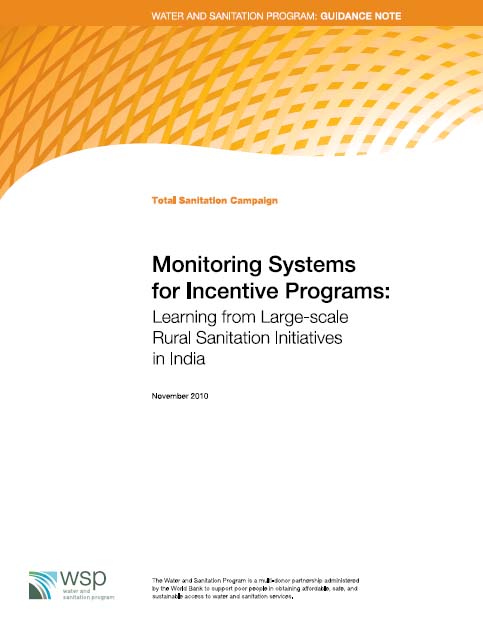Sanitation
Uttar Pradesh Urban Sanitation Policy Jawaharlal Nehru National Urban Renewal Mission Government of India 2010
Posted on 22 Nov, 2014 10:30 AMThe factors that lead to this poor sanitation situation in the city include:
Capacity and investment in the water supply and sanitation sectors - Guidelines in respect of participation of cooperative institutions 2006 Water Supply and Sanitation Department Government of Maharashtra
Posted on 22 Nov, 2014 10:30 AMIt argues that this is because civil bodies are facing many problems due to urbanisation and increasing demand from the residents. There is a need to increase efficiency in the water supply and sewage.
Monitoring systems for incentive programmes Learning from large scale rural sanitation initiatives in India
Posted on 22 Nov, 2014 10:30 AMDepartment of Drinking Water and Sanitation Information on water and sanitation in India
Posted on 22 Nov, 2014 10:30 AMA huge number of links are present on these sites which provide access to various data and information regarding the status of rural drinking water & sanitation and related government projects.
Study of water supply sanitation practices in India using geographic information systems Some design other considerations in a village setting IJMR research paper
Posted on 22 Nov, 2014 10:30 AMThe study attempted to understand the phenomenon of water contamination in the village by using GIS as a tool to locate and map water supply and sewage distribution systems in the village, in relation to human and animal dwellings, their wastes, sanitary practices and their connections with drinking water quality for a clearer understanding of the connections between these factors and possible
Upward revision of incentive amount for construction of individual household latrine under Total Sanitation Campaign PIB Release
Posted on 22 Nov, 2014 10:30 AMThe incentive for one unit of Individual Household Latrine (IHHL) has been raised from existing Rs. 2,200 (Rs. 2,700 for difficult and hilly areas) to Rs. 3,200 (Rs. 3,700 for difficult and hilly areas). The central share out of this shall be Rs. 2,200 (Rs. 2,700 in case of hilly and difficult areas) and State Government share shall be Rs. 1,000. Minimum beneficiary share shall be Rs. 300. State Governments are allowed the flexibility to provide higher incentive for a household toilet, of the same or higher unit costs from their own funds.
Shit Matters The potential of CLTS Statelevel sensitisation workshop on CLTS held in Patna Updates from the CLTS May 2011 Newsletter
Posted on 22 Nov, 2014 10:30 AMContent Courtesy:
Main highlights in this update:
- Shit Matters: The Potential of Community-led Total Sanitation: This book looks at the potential and challenges of CLTS by drawing on research in Bangladesh, India and Indonesia, as well as experiences in Africa. It includes chapters by leading scholars and practitioners in sanitation policy and practice as well as critical reflections from key players in CLTS. Shit Matters considers CLTS in terms of the social, ecological, technological, financial, and institutional dynamics and draws out wider lessons for sanitation policy and practice.
Monitoring system for incentive programs Learning from largescale rural sanitation initiatives in India A report by the Water and Sanitation Programme
Posted on 22 Nov, 2014 10:30 AM It is a part of the Global Scaling Up Rural Sanitation project of the Water and Sanitation Programme, World Bank and focuses on learning how to combine the approaches of Community Led Total Sanitation (CLTS), behavior change communications, and social marketing of sanitation to generate sanitation demand and strengthen the supply of sanitation products and services at scale, leading to improved health for people in rural areas. This is one in a series of knowledge products designed to showcase project findings, assessments and lessons learned in the project.
It is a part of the Global Scaling Up Rural Sanitation project of the Water and Sanitation Programme, World Bank and focuses on learning how to combine the approaches of Community Led Total Sanitation (CLTS), behavior change communications, and social marketing of sanitation to generate sanitation demand and strengthen the supply of sanitation products and services at scale, leading to improved health for people in rural areas. This is one in a series of knowledge products designed to showcase project findings, assessments and lessons learned in the project.
Over the last few years, the concept of open-defecation free communities has emerged as one of the building blocks toward achieving total sanitation. The term ‘access’ is widely used to capture increase in sanitation usage. However, a clean environment is a public good. Hence, there was a need to achieve total sanitation at the community level to realize public health benefits. This has led policy makers and practitioners to adopt strategies that achieve community-wide total sanitation status, which includes the community becoming open-defecation free, and adopting safe hygiene and environmental sanitation practices.
Honeysuckers How Bangalores sewage is managed A film by Gautam Vishwanath and Celine Thizy
Posted on 22 Nov, 2014 10:30 AM
Delight - Indias first electronic public toilet in Thiruvanthapuram Kerala
Posted on 22 Nov, 2014 10:30 AMWarm Greetings from Eram Scientific Solutions!!!
, is the part of USD $1 Billion, Eram Group. Eram Scientific is based out of Thiruvananthapuram, Kerala and working for addressing the pressing needs of the society through the effective use of Technology. We are giving much emphasis to R&D and now developing solutions to prevent Food Adulteration, Ensuring Women Safety, and Using Non Conventional Energy.
Delight is the blend of Information Communication and Engineering Technologies.





